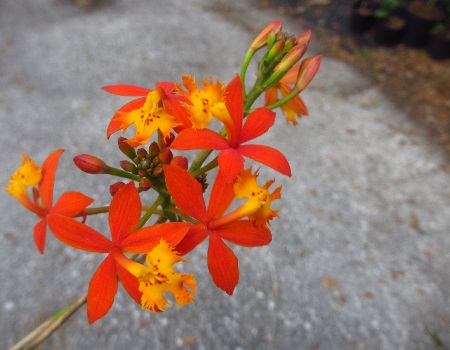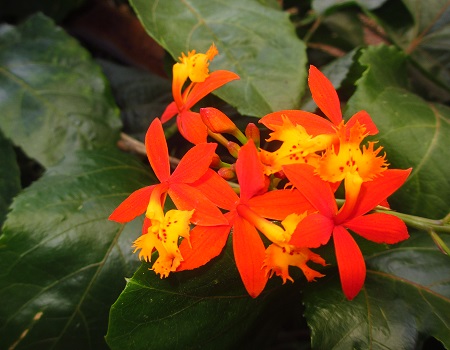This Mexican orchid is ridiculously easy to grow. Here in Florida they can be grown as a landscaping plant or as a container specimen.
In Hawaii and other places in the tropics, this has established itself as an invasive species, growing profusely along roadsides where they thrive.
That is good newsd for the orchid growing beginner. These are very forgiving. Freezing temperatures will kill them but above freezing they can take cold pretty well.
Origin
AfrMexico and Central America
Family
Orchidaceae
Binomial nomenclature
Epidendrum radicans
Common names
Mexican reed orchid
Description
E. radicans, like other members of subgenus Amphiglottium, is a sympodial orchid which grows stems which do not swell into pseudobulbs and are covered with imbricating sheaths, produces a terminal inflorescence covered at its base by close imbricating sheaths, and produces a lip adnate to the column to its apex. The lip of E. radicans is trilobate, as with the other members of section Schistochila, with the lacerate lobes which are typical of the subsections Carinata and Tuberculata. E. radicans differs from the other lacerate Schistochila by producing roots from most of the stem.
E. radicans seeds are quite small, at 320 seeds per milligram.
(description taken from wikipedia)
Height
3′ tall.
Temperature/Zone
zone 9b, 32°F. This plant prefers humid conditions.
Light
Part sun to full sun.
Water
Epidendrum radicans likes frequent water in the Summer, but they are surprisingly drought tolerant. I back off on water in Winter.
Fertilizer
I use a general purpose granular fertilizer.
Cultivation
These are terestrial orchids, that grow in loose soil alond the edgesd of tree lines. I grow them in a mix of orchid bark and potting soil. They quickly grow outside of the pot and the aerial rootsd grow down into the pots of surrouinding plants. They like to grow in beds of thickly laid cyperus mulch or other wood chips. a tomato trellis or other support will help keep them upright until they establish themselves as a large specimen where the stems will become tangled in themselves and support each other.
Pests
I have not found any pests to be a problem for this plant in Florida.


